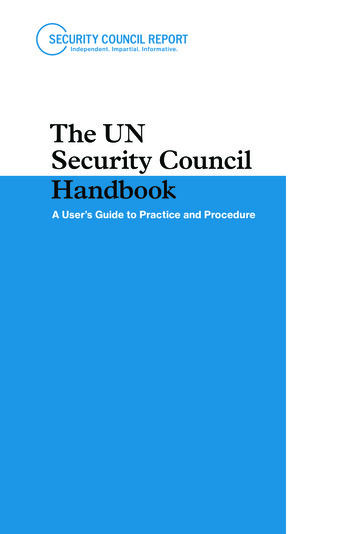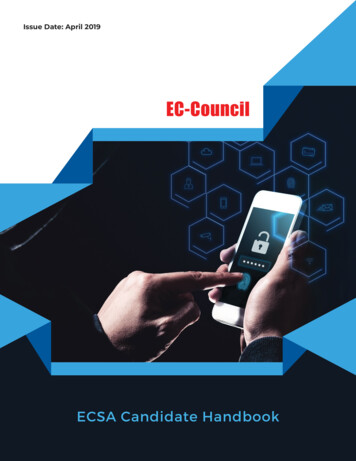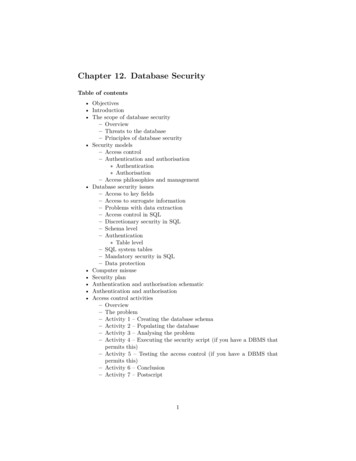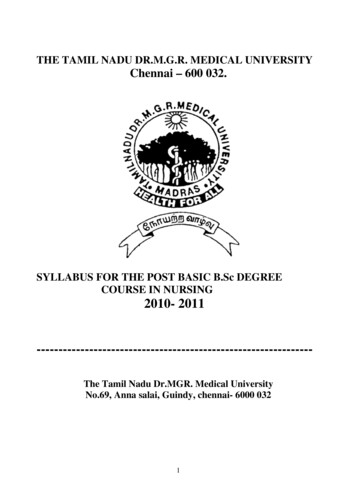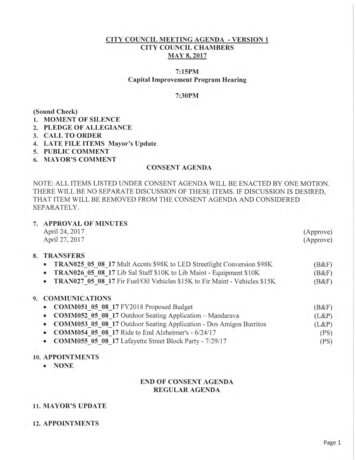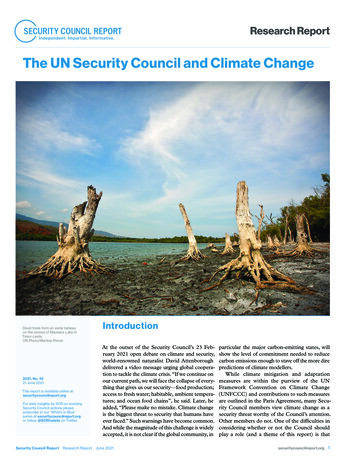
Transcription
Research ReportThe UN Security Council and Climate ChangeDead trees form an eerie tableauon the shores of Maubara Lake inTimor-Leste.UN Photo/Martine Perret2021, No. #221 June 2021This report is available online atsecuritycouncilreport.org.For daily insights by SCR on evolvingSecurity Council actions pleasesubscribe to our “What’s In Blue”series at securitycouncilreport.orgor follow @SCRtweets on Twitter.IntroductionAt the outset of the Security Council’s 23 February 2021 open debate on climate and security,world-renowned naturalist David Attenboroughdelivered a video message urging global cooperation to tackle the climate crisis. “If we continue onour current path, we will face the collapse of everything that gives us our security—food production;access to fresh water; habitable, ambient temperatures; and ocean food chains”, he said. Later, headded, “Please make no mistake. Climate changeis the biggest threat to security that humans haveever faced.” Such warnings have become common.And while the magnitude of this challenge is widelyaccepted, it is not clear if the global community, inSecurity Council Report Research Report June 2021 particular the major carbon-emitting states, willshow the level of commitment needed to reducecarbon emissions enough to stave off the more direpredictions of climate modellers.While climate mitigation and adaptationmeasures are within the purview of the UNFramework Convention on Climate Change(UNFCCC) and contributions to such measuresare outlined in the Paris Agreement, many Security Council members view climate change as asecurity threat worthy of the Council’s attention.Other members do not. One of the difficulties inconsidering whether or not the Council shouldplay a role (and a theme of this report) is thatsecuritycouncilreport.org1
1Introduction2The Climate-SecurityConundrum4The UN Charter and SecurityCouncil Practice5Security Council Engagement:Evolution and Key Themes9Institutional Developments12 Council Dynamics: The CurrentState of Play14 Options for Action18 Annex I: Thematic Meetings onClimate-Security Matters19 Annex II: Formal Meetings onTopics Related to Climate andSecurity20 Annex III: Arria-FormulaMeetings on Climate-SecurityMatters21 Annex IV: Climate ChangeLanguage in Security CouncilOutcomes27 Annex V: Other Security CouncilKey Documents on ClimateChange and SecurityIntroductionthere are different interpretations of what isappropriate for the Security Council to doin discharging its Charter-given mandate tomaintain international peace and security.Notwithstanding these tensions, the issuehas gained traction in the Council in recentyears. An increasing number of Council members are choosing to hold signature events on climate change and security, during their monthlyCouncil presidencies, to support the integrationof climate change language into formal Counciloutcomes (that is, resolutions and presidentialstatements), and more broadly, to approachpeace and security issues with greater sensitivity to the harmful effects of climate change.In open debates and Arria-formula meetings, Council members and other memberstates have also increasingly framed this riskin more holistic terms, linking climate changeand security to other thematic issues on theCouncil’s agenda. For example, they often discuss the impacts of climate change on womenand youth—and the role that these groups canplay in responding to climate-security risks—and they explore how climate change, pandemics, hunger, and conflict interact to compound security risks in conflict-affected andother vulnerable settings. Council membershave often seen efforts to tackle climate-security threats as an element of the UN system’sconflict prevention work, and in more recentyears, many of them have also viewed addressing climate change as an important part of theUN’s peacekeeping, peacebuilding and sustaining peace efforts.A further focus of this report is the significant institutional architecture that has beenestablished just since 2018, both within andoutside the UN system, to help undergird theefforts of the Security Council and the broader UN family on this issue. This has included the establishment of an Informal ExpertGroup of Members of the Security Council onClimate and Security and a Group of Friendson Climate and Security, among other initiatives. These developments have largely reflected the initiative of Council members and othermember states to foster a better understanding of climate-security risks and consistentand meaningful responses to them.Efforts within UN peace operations todevelop responses to climate-related security threats continue to make progress, butare uneven and lack sufficient resources. TheCouncil can enhance its focus on climaterelated security matters, but in order for climate risks to be assuaged in relevant situations on the Council’s agenda, the rest of theUN system will need to continue to build itscapacity and expertise on this issue.The report explores the above-mentionedthemes in the following sections: The first section briefly analyses whetherthe Council is an appropriate venue toaddress climate-security matters. The second section looks to the UNCharter and Security Council and General Assembly practice for guidance onCouncil involvement on climate changeand security matters. The third section outlines the ways inwhich the Council has engaged on thisissue in meetings and in formal outcomes.It also describes the institutional mechanisms that have been established to helpthe Council and the UN more broadly toaddress climate-related security threats ina more consistent and impactful manner. The fourth section discusses Security Council dynamics on climate change and security. The fifth section offers some observationson the Council’s approach to climate andsecurity matters and presents options forthe way forward.The report concludes with annexes summarising climate change language in Security Council outcomes, and listing other relevant documents.The Climate-Security ConundrumThe Council is the UN organ conferredunder Article 24 of the UN Charter with theprimary responsibility for the maintenanceof international peace and security. Addressing the challenges of climate change does notfit neatly into conventional notions of peaceand security, which tend to focus narrowly2securitycouncilreport.org on the absence of violent conflict. Moreover,the Council must make choices about effective time and resource allocation. Its agendais already packed with crises featuring moreevidently direct drivers of insecurity: somequestion how much time the Council shouldaccord to climate and security matters, whenSecurity Council Report Research ReportJune 2021
The Climate-Security Conundrumfaced with more immediate threats to peace and security in particular situations.The best way to avert the worst security impacts of climatechange lies in significantly reducing global carbon emissions. Asthe UNFCCC is the primary vehicle through which such effortsare pursued, no one would reasonably expect the Security Council to play a key role in this regard. It is similarly highly unlikelythat the Council would sanction those countries most responsiblefor carbon emissions, especially as some of the body’s permanentmembers are among the world’s biggest emitters and would resistsanctioning themselves.1As well, the relationship between climate change and conflict complex and not well understood. In one article based on interviews with12 leading social scientists, the authors conclude that low socioeconomic development, low state capacity, intergroup inequality, anda past history of conflict are most associated with conflict risk andthat “climate variability and/or change is low on the ranked list ofmost influential conflict drivers across experience to date”.2 Thereare “notable uncertainties about climate-conflict links”, and thereis “limited understanding” of these connections, “whether throughagriculture, economic shocks, disasters or migration”.3 In addition,although climate change may be one of many factors leading to orexacerbating conflict, it can be a challenge to pinpoint its exact roleor the relative strength of its impact; this conceptual murkiness, inturn, makes it difficult to offer effective policy prescriptions4 —presenting a dilemma for an organ such as the UN Security Councilin identifying concrete measures to tackle the security implicationsof climate change. As Conca has written, “While conflict modelersagree on the importance of several contextual factors, there is nosingle, consensual ‘base model’ to which climate-related factors maysimply be added.”5Despite these conceptual difficulties, there are persuasive arguments to support the Security Council’s engagement on climatechange and security. While Sakaguchi et al. question the extent ofthe climate change-security connection, they nonetheless note that“62.3 percent of the studies [in their analysis] find evidence that climate change variables are associated with higher levels of conflict.”6They add that more work is needed on understanding the role ofclimate change in causal mechanisms related to conflict;7 an argument for more research on this relationship, rather than a dismissalof such a connection. In this regard, in a recent article assessing theliterature over the past decade on the relationship between climatechange and security, the authors note, “more than half of the reviewstudies considered here have called for more research that explicitlyinvestigates pathways and intermediate factors”.8Furthermore, there is wide agreement that climate change isa risk multiplier.9 In a report jointly issued by two leading thinktanks on climate policy, the authors observe that, among its negativeeffects, climate change can “increase resource demands, environmental degradation and uneven development, and exacerbate existing fragility and conflict risks”.10 They further note that while climatechange is “rarely a direct cause of conflict there is ample evidencethat its effects exacerbate important drivers and contextual factorsof conflict and fragility, thereby challenging the stability of states andsocieties”.11 With mitigation efforts to date failing to curb globalwarming, it is also clear that climate change will become a greaterrisk factor for conflict in the future.12 As its security implicationsbecome more grave, the Council may increasingly be compelledto address the climate crisis. In the meantime, the Council has aCharter-mandated conflict prevention role that supports addressingclimate risks before they deteriorate into violence.In addition, implementing the risks assessments and risk management strategies that the Council has encouraged in various settingscan play a meaningful security role. As the International Crisis Grouphas argued, “while climate change itself does not cause conflict per se,resource governance—how people in power manage access to land,water and other parts of nature’s bounty amid climate change—canincrease or reduce the risk of violence”.13 Examples of risk management strategies could include working with host governmentsand other local actors to develop transhumance routes that limit thepotential for conflict between communities or mediating betweendifferent groups contesting dwindling resources.Nonetheless, the Council is still searching for how it can mosteffectively address the adverse effects of climate change, and how itsefforts relate to those of the constellation of actors within and outside the UN system working towards the same goal. As the Councilgrapples with the most appropriate role to play on climate changeand security, it is important to underscore that the Council’s voicematters, especially on an issue of such global importance. For all itsfaults, the Security Council is the most powerful and perhaps the1. Binder, Martin, and Monika Heupel. 2018. “Contested Legitimacy: The UN Security Council and Climate Change.” In Climate Change and the UN Security Council, by Charlotte Ku and Shirley V. Scott,186-208. Northampton: Edward Elgar Publishing, pp.191-192. Binder and Heupel similarly note “ while the Council has the legal authority to authorize the use of force against states whose failureto substantially reduce their C0₂ emissions it deems to constitute a threat to peace and security, such a step is still no plausible scenario given that three of the five permanent Council members(P5) – the United States, China and Russia – are among the world’s largest emitters”.2. Mach, Katharine J., Caroline M. Kraan, W. Neil Adger, Halvard Buhaug, Marshall Burke, James D. Fearon, Christopher B. Field et al. “Climate as a risk factor for armed conflict.” Nature 571, no. 7764(2019): 193-197, p.4.3. Mach, Katharine J., and Caroline M. Kraan. “Science–policy dimensions of research on climate change and conflict.” Journal of Peace Research (2021): 0022343320966774. p.169.4. Sakaguchi, Kendra, Anil Varughese, and Graeme Auld. “Climate wars? A systematic review of empirical analyses on the links between climate change and violent conflict.” International StudiesReview 19, no. 4 (2017): 622-645, p.641.5. Conca, Ken. “Is there a role for the UN Security Council on climate change?.” Environment: Science and Policy for Sustainable Development 61, no. 1 (2019): 4-15, p.7.6. Sakaguchi, Kendra, Anil Varughese, and Graeme Auld. “Climate wars? A systematic review of empirical analyses on the links between climate change and violent conflict.” International StudiesReview 19, no. 4 (2017): 622-645, p.640.7. Ibid, 624.8. von Uexkull, Nina, and Halvard Buhaug. “Security implications of climate change: a decade of scientific progress.” (2021): 3-17, p.6.9. Adrien Detges, Daniel Klingenfeld, Christian König, Benjamin Pohl, Lukas Rüttinger, Jacob Schewe, Barbora Sedova, and Janani Vivekananda,. 2020. 10 Insights on Climate Impacts and Peace: ASummary of What We Need to Know. Berlin: Adelphi, Potsdam Institute for Climate Impact Research. ments/10 insights on climate impacts and peace report.pdf, p.11.10. Ibid, p.11.11. Ibid, p.4.12. United Nations. 2020. “Climate Security Mechanism, Toolbox, Briefing Note.” https://dppa.un.org/sites/default/files/csm toolbox-1-briefing note.pdf, p.4.13. International Crisis Group. 2021. How Climate Science Can Help Conflict Prevention. April 20. ence-can-help-conflict-prevention.Security Council Report Research Report June 2021 securitycouncilreport.org3
The Climate-Security Conundrummost recognisable part of an international institution that still commands a high level of respect across the globe.14 The Security Councilmay not have all or even many of the answers to the security effectsof climate change, but it can be expected to galvanise awareness ofand international responses to a crisis whose threat to internationalpeace and security will likely continue to grow.The UN Charter and Security Council PracticeThe UN Charter is the starting point for assessing whether the Security Council can play a role on climate change and security. The UN’sfounders did not foresee the threat of climate change, but there areclues both in the Charter and in Council practice that might helpaddress important questions that are frequently raised.the array of issues that it addresses. This broader perspective is consistent with the view that threats to “human security”—defined byGeneral Assembly resolution 66/290 as an “approach to assist Member States in identifying and addressing widespread and cross-cuttingchallenges to the survival, livelihood and dignity of their people”—not only heighten the risk of conflict but also undermine efforts tosustain peace and stability in a long-term, durable way. In this respect,members continue to address various issues that reflect an expandedvision of the Council’s mandate and encompass human security concerns, such as the protection of civilians, children and armed conflict,sexual violence in armed conflict, pandemics, and hunger and conflict. Human rights abuses—perceived by many Council membersas a risk factor for conflict, as are other human security threats—arediscussed in the Council’s work in country-specific situations, just asclimate change is, although not without controversy.Is the Council overstepping its authority by delving into anissue that may often only have tangential links to conflict?It is the Council’s prerogative to decide what matters it shouldaddress. Member states and the Secretariat can refer situationsand disputes to the Council, but the Council itself is the ultimatearbiter of its own work. The precise nature of “international peaceand security” in Article 24 (1) is not specified, and it is up to theCouncil to determine what this entails.15 The lack of a clear definition of “peace and security” in the Charter may be one reasonwhy determining what issues fit appropriately within the Council’smandate is so hotly contested.Is the Council infringing on the authority of other UNThe Security Council’s efforts to combat climate change are organs with more expertise in this area?often cast in terms of its conflict prevention work—a need to Based on the Charter, it appears that different organs should be ableunderstand and respond to a severe environmental challenge that to simultaneously address an issue, such as climate change, whichcan exacerbate the risk of conflict. In this regard, the Charter is straddles the various pillars of the UN’s work (peace and securireplete with conflict prevention language, beginning with the pre- ty, development and human rights). While the Charter lays out theamble, whose opening lines highlight the determination of the responsibilities of the different organs of the UN system, it does notUnited Nations “to save succeeding generations from the scourge separate them into silos. The Charter links different parts of the UNof war”. Article 34 of Chapter VI on “Pacific Settlement of Dis- system, suggesting that various UN organs and bodies were intendedputes” is particularly relevant, as it states:by the framers of the Charter to work together to address complexThe Security Council may investigate any dispute, or any situissues. For example, under Article 11 (3), the General Assemblyation which might lead to international friction or give rise to a“may call the attention of the Security Council to situations which aredispute, in order to determine whether the continuance of the disputelikely to endanger international peace and security”, while ECOSOCor situation is likely to endanger the maintenance of international“may furnish information to the Security Council and shall assist thepeace and security.Security Council upon its request”, according to Article 65. In pracThe terms “situation” and “dispute” are broad enough to include tice, although the Council most frequently draws on the expertisea wide range of phenomena. Climate change could reasonably be and advice of the Secretariat, it also, on occasion, makes use of theamong these, even if one were to consider it as primarily a sustain- input of the General Assembly, ECOSOC and other UN entities. Inable development issue. As Luck has argued: “Article 34’s references this regard, the ECOSOC president has briefed the Security Councilto ‘disputes’ and ‘situations’ undoubtedly encompassed economic on various occasions during the last two decades; the last such briefand trade issues, as well as social and human rights matters”, adding ing was in November 2020 during a high-level open videoconferencethat a “number of delegations at San Francisco [where the Charter session on “contemporary drivers of conflict and insecurity”, underwas drafted] emphasised the economic and social roots of conflict”.16 the Peacebuilding and Sustaining Peace agenda, in a meeting thatThe trajectory of Security Council practice also reflects prece- focused largely on the implications of climate change and COVID-19dents for this organ to have a role on climate change and security on peace and security.matters. Since the end of the Cold War, the Council has broadenedWhile some member states emphasise that climate change is14. Fagan, Moira, and Christine Huang. 2019. United Nations Gets Mostly Positive Marks from People Around the World. September 23. e-around-the-world/A 2019 Pew Research Center Poll found that: “Across 32 surveyed countries [in various regions], a median of 61% have a positiveview of the UN, while a median of just 26% have a negative view.”.15. Penny, Christopher K. 2018. “Climate Change as a ‘Threat to International Peace and Security’.” In Climate Change and the UN Security Council, by Charlotte Ku and Shirley V. Scott, 25-46.Northampton: Edward Elgar Publishing, p.34. Penny has likewise observed, “The Charter itself does not define ‘threat to international peace and security’ (or, to be more precise, ‘threat to the peace,breach of the peace or act of agression’). Instead, the meaning of this concept has developed through actual organizational practice.”16. Luck, Edward, C. 2014. “Change and the United Nations Charter.” In Charter of the United Nations Together with Scholarly Commentaries and Essential Historical Documents, by Ian Shapiro andJoseph Lampert, 121-142. New Haven: Yale University Press, p.129.4securitycouncilreport.org Security Council Report Research ReportJune 2021
The UN Charter and Security Council Practiceprimarily a sustainable development issue outside of the Council’spurview, those holding a less traditional view of peace and securitymight note that the Security Council—and the wider UN membership—has explicitly emphasised the linkages between security anddevelopment on numerous occasions. In January 1992, at the dawnof the post-Cold War era, the Security Council met at the heads ofstate and government level for the first time in its history to discussthe agenda item: “The responsibility of the Security Council in themaintenance of international peace and security”.17 In the presidential statement adopted at the end of the meeting, the Council stated: “The non-military sources of instability in the economic, social,humanitarian and ecological fields have become threats to peaceand security.”18 In the 2005 World Summit Outcome Document, theworld’s heads of state and government reaffirmed their “commitment to work towards a security consensus based on the recognitionthat many threats are interlinked, that development, peace, securityand human rights are mutually reinforcing”.19 And more recently,in the April 2016 resolution adopted concurrently with the GeneralAssembly on the UN peacebuilding architecture, the Security Council affirmed that one of the roles of the Peacebuilding Commissionis to: “promote an integrated, strategic and coherent approach topeacebuilding, noting that security, development and human rightsare closely interlinked and mutually reinforcing.”20These pronouncements about the linkages between peace andsecurity, on the one hand, and development, on the other, wouldseem to suggest a role for the Security Council on climate change andsecurity, working on the issue in conjunction with other UN entities.However, there is a caveat to this view. Security Council outcomesthat emphasise the security-development nexus also at times refer tothe distinct activities of various UN bodies, which can be perceivedas a nod to the concerns about infringement on the prerogatives ofother UN entities. For example, while resolution 2282 (the sustainingpeace resolution of 27 April 2016) recognises the linkages betweensecurity and development, it also recognises that “an integrated andcoherent approach among relevant political, security and development actors, within and outside of the United Nations system, consistent with their respective mandates [emphasis added], and the Charterof the United Nations, is critical to sustaining peace.”21 This impliesan effort to distinguish between the roles of different UN entities, asthose with a more conservative view of “international peace and security” might point to the reference to “respective mandates” as a wayof differentiating the Council’s work from that of other UN entities.General Assembly resolution 63/281(2009) on “Climate Changeand its possible security implications” is another document opento interpretation as to whether the Council encroaches on the prerogatives of other organs with respect to climate change, reflectingthe tensions among the membership on this issue. In that resolution, the General Assembly recognises the different responsibilitiesof UN organs, maintaining that the Security Council is primarilyresponsible for peace and security and that the General Assemblyand ECOSOC are responsible for sustainable development issues,including climate change.22 Read in isolation, this implies that theCouncil does not have a role with regard to climate change. However,the resolution also invites “the relevant organs of the United Nations,as appropriate and within their respective mandates, to intensify theirefforts in considering and addressing climate change, including itspossible security implications” [emphasis added].23 This could be interpreted as envisioning a potential role for the Security Council, in lightof the “possible security implications” of climate change.Security Council Engagement: Evolution and Key ThemesDespite the challenging road that the Council has travelled on climate and security matters since 2007, its engagement has persistedand accelerated significantly in the past few years. Not only are moremeetings being held on climate change and security as a thematictopic, but language on climate change and security is increasinglybeing included in Security Council outcomes.Council Debates and Briefings on Climate Change andSecurityThe Security Council has had several thematic debates on climateand security matters. The first time the Council focused explicitlyon climate change as a thematic topic was on 17 April 2007 during a ministerial-level open debate on the relationship betweenenergy, security and climate, which was convened by the UK andincluded a briefing by Secretary-General Ban Ki-moon.24 Prior tothe meeting, the Non-Aligned Movement (NAM) and the Groupof 77 (G77) China sent letters to the Security Council expressingconcern about infringement on the work of the General Assemblyand the Economic and Social Council. However, there have beenfissures in the NAM and the G77 on this issue over the years, withseveral members from both groups supporting Council engagement on climate change and security.17. United Nations. 1992. Security Council 3046th meeting. January 31. 046.pdf.18. United Nations. 1992. Note by the President of the Security Council S/23500. January 31. 500.pdf.19. United Nations. 2005. Resolution adopted by the General Assembly 60/1. 2005 World Summit Outcome. September 16. migration/generalassembly/docs/globalcompact/A RES 60 1.pdf.20. United Nations. 2016. Security Council Resolution 2282 (2016). April 27. https://undocs.org/S/RES/2282(2016), p.1.21. Ibid, p.2.22. Vivekananda, Janani, Day, Adam, and Susanne Wolfmaier. 2020. What can the UN Security Council do on Climate and Security? Berlin: Climate Security Expert Network. /what can the un security council do on climate and security v2.pdf, p.10.23. United Nations. 2009. General Assembly Resolution A/RES/63/281. June 3. https://undocs.org/A/RES/63/281, op.1.24. United Nations. 2007. Security Council 5663rd meeting. April 17. BFCF9B-6D27-4E9C-8CD3-CF6E4FF96FF9%7D/s pv 5663.pdfSecurity Council Report Research Report June 2021 securitycouncilreport.org5
Security Council Engagement: Evolution and Key ThemesThe Council again took up climate change on 20 July 2011, inan open debate initiated by Germany that featured a briefing bySecretary-General Ban and Achim Steiner, the Executive Directorof the UN Environment Programme.25 It adopted a presidentialstatement, which was only finalised during the debate, after difficultnegotiations.26 Early in the meeting, with the fate of the documentstill unclear, Ambassador Susan Rice (US) complained about theCouncil’s inability “to reach consensus on even a simple draft presidential statement that climate change has the potential to impactpeace and security in the face of the manifest evidence that it does”.Failure to reach agreement would be “pathetic” and “a derelictionof duty”, she added.While modest in substance, the presidential statement markedthe first and, by mid-2021, the Security Council’s only thematicproduct on climate change and security. It reaffirmed that the UNFramework Convention on Climate Change “is the key instrumentfor addressing climate change”. It expressed concern that possibleadverse effects of climate change may, in the long run, aggravate certain existing threats to international peace and security. And it notedthe importance of including conflict analysis and contextual information on the possible security implications of climate change in theSecretary-General’s reports, “when such issues are drivers of conflict,represent a challenge to the implementation of Council mandates orendanger the process of consolidation of peace”. Implementation ofthis presidential statement was generally weak for many years, in partbecause of the lack of capacity of the Secretariat to follow throughon this request, but action has picked u
the climate change-security connection, they nonetheless note that “62.3 percent of the studies [in their analysis] find evidence that cli-mate change variables are associated with higher levels of conflict.”6 They add that more work is needed on understanding the role of climate change



